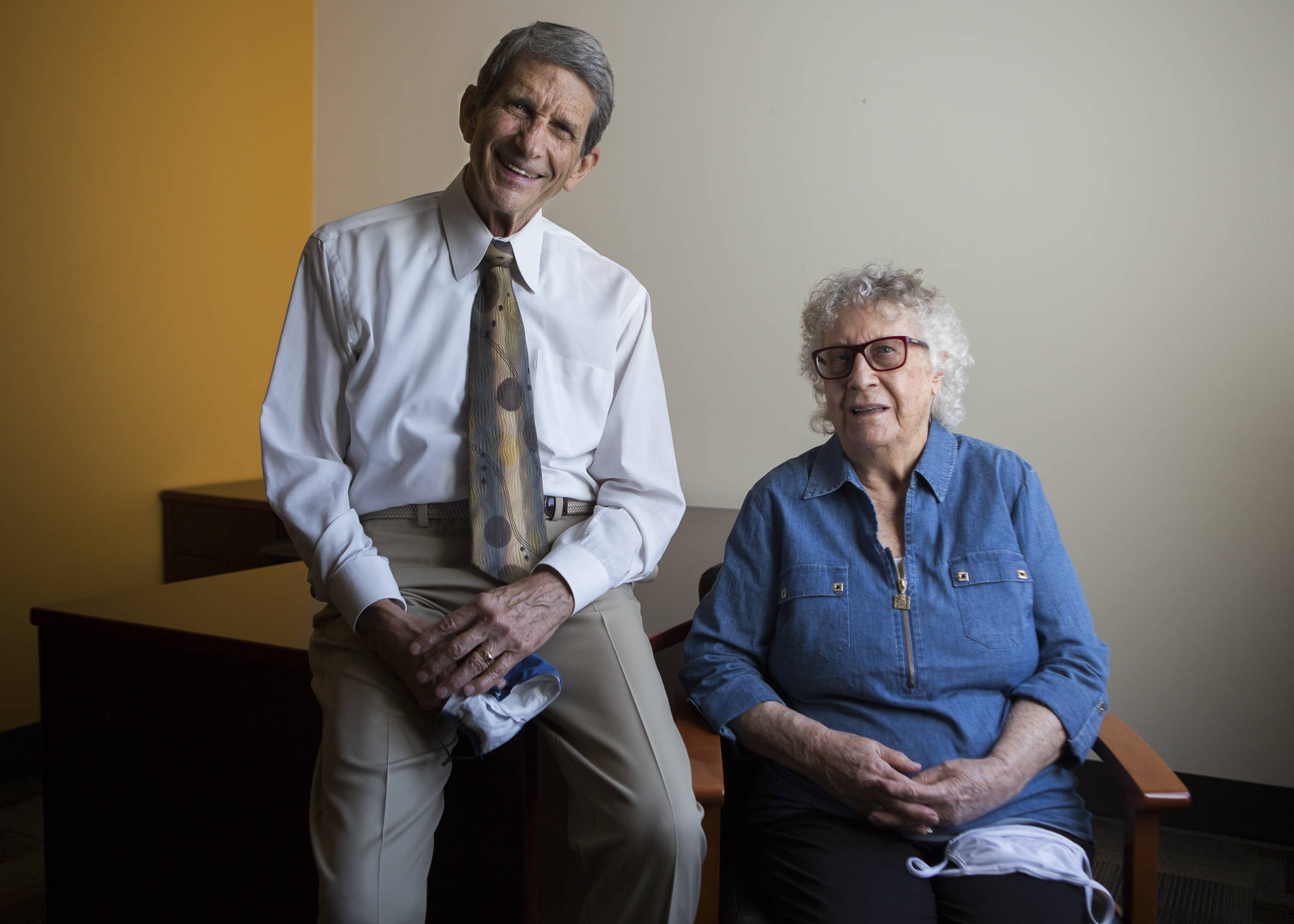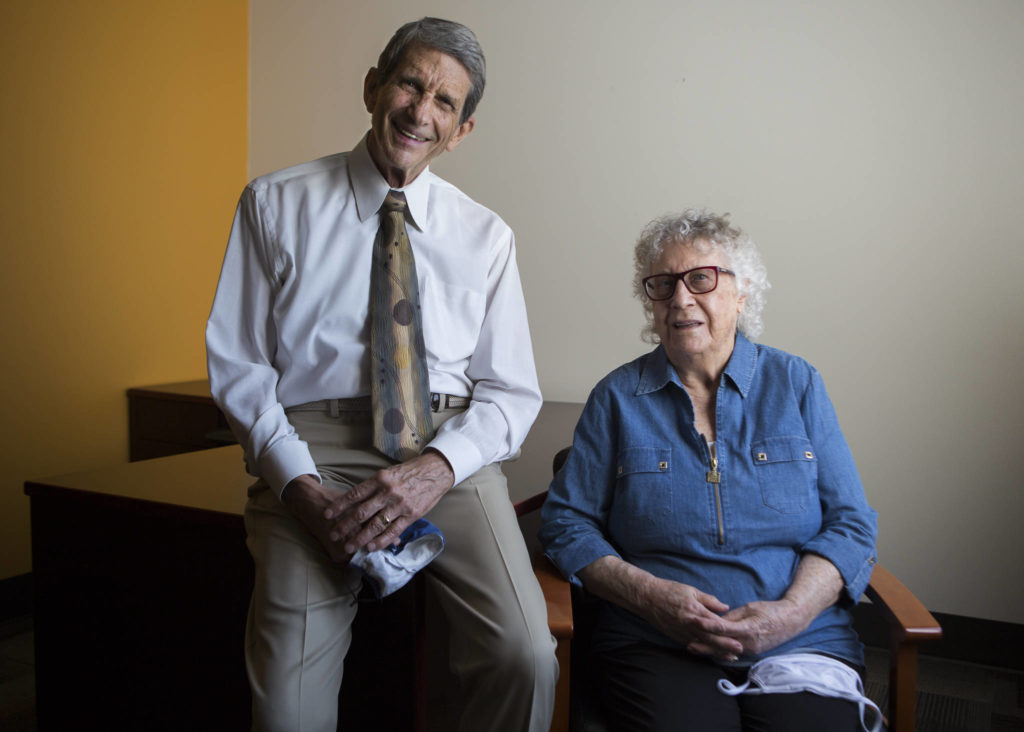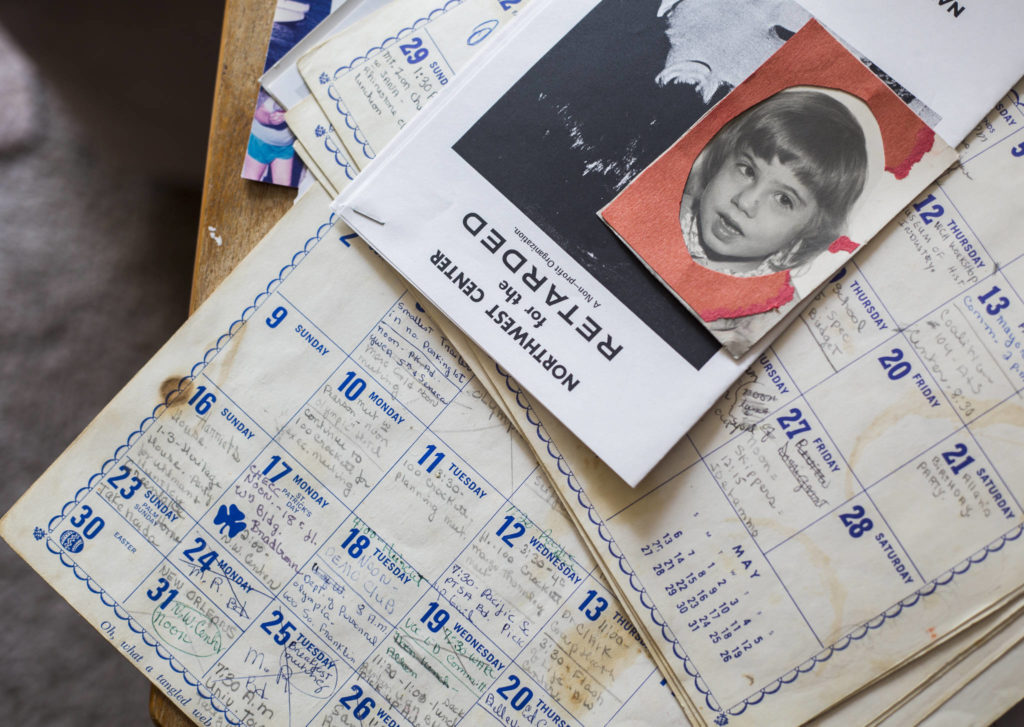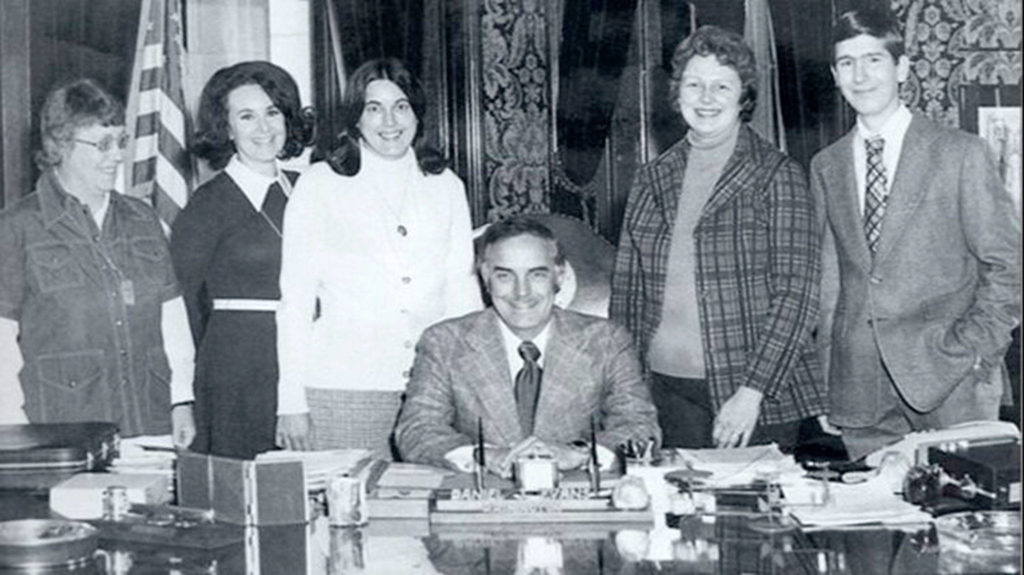It was 1970, the start of a decade of change.
A motley crew of two bell-bottomed men in their early 20s and four women twice their age piled into a VW van with balding tires and set out from Seattle on road trips around Washington.
They talked to parents, teachers, politicians — anybody who would listen and also those who wouldn’t.
Their goal: overhaul the state school system to educate all students with disabilities, not just the most high-functioning.
Janet Taggart was one of the moms in the tan van. She had a daughter who was among 4 million American children being refused a public education. She didn’t think that was fair. Neither did the other three women in the van, two of whom had sons with autism.
The guy with the long dark sideburns behind the wheel, Bill Dussault, was a second-year law student at the University of Washington. The moms recruited him and a fellow classmate to write a bill that would give all children the right to an education. Back then, the few school programs outside of institutions were for children with mild learning disabilities. Thousands in Washington were excluded, with no recourse. Disability laws didn’t exist.
People told the six crusaders they were wasting their time, saying it would take power, money and years to pass such a bill.
“Everybody always assured us it couldn’t possibly be done,” Taggart said a half-century later.
That only made them more determined. Days were spent hashing out every detail.
“Me with my electric typewriter; Bill with a pile of law books,” Taggart said.
“We’d take drafts and sit around and wordsmith it,” Dussault said.
Their mission was to pass a law with teeth. What they came up with was short yet pointed, and the genesis for a civil rights milestone.
Eight months after their first September road trip, Gov. Dan Evans signed House Bill 90 “Education for All” into law in May 1971. It was the first law in the United States that mandated a state to educate all special needs children, regardless of the level of disability.
“Here’s this 13-section bill written by these six complete novices that goes through the Legislature and we got a $5.2 million appropriation,” Dussault said.
The six didn’t stop there.
“It was just the first step. We just kept going,” Dussault said. “We turned public education for kids with disabilities on its ear.”
They went to Washington, D.C., to meet with Sen. Warren Magnuson, who wielded considerable power in Congress.
“He said, ‘You mean these kids can’t go to school?’ He was completely surprised there was this whole group of kids that can’t go to school,” Dussault said. “He put his full weight behind it. And then Kennedy got behind it, too.”
Kennedy as in Ted, the senator.
Their statute was the model for the federal Education for All Handicapped Children Act of 1975. On another trip to D.C. they met Kennedy.
“It was an evolution that became a revolution,” Taggart said. “We were just doing what we had to do.”
The feat is the focus of a short documentary under production by Whidbey Island filmmaker Jerry Millhon, who hopes to gain a national audience for what is tentatively titled, “Four Women Who Changed the Nation.”
Of the six trailblazers, Taggart and Dussault are the only two still alive. The others were Cecile Lindquist, Evelyn Chapman, Katie Dolan and law student George Breck.
Taggart, 90, lives in a SHAG senior living community in north Seattle. She continues to champion for the disabled by writing articles and letters to the editor.
Dussault, 73, a Langley resident, has devoted his career and Seattle legal practice to disability issues. His daughter Amy Dussault, of Lynnwood, is a special education teacher at Northshore Middle School in Bothell.
“This was a civil rights law, not just an education law,” he said. “This opened the door to claims by individuals with disabilities to all of the other rights we expect and enjoy. The right to an education unlocked the gate.”
‘No place here for you’
Janet Taggart and her husband, Phil, were first-time parents when their daughter Naida was born in 1957. The prognosis was grim. Their baby girl had epilepsy and cerebral palsy.
“One doctor said, ‘Just take her home and enjoy her while you can,’” Taggart said. “I slept on the floor by her crib because I didn’t want her to die alone.”
Naida overcame formidable odds, as did her parents.
At the time, many children with special needs were lumped into a catch-all category — labeled simply as “retarded” — and housed in state-run institutions. Naida’s mom and dad paid a visit to one.
“All these people were just milling around, just walking around in this one room in each building,” Taggart said. “I knew if Naida went there that she would think that was her job, that she was supposed to mill around. She wanted to be like everyone else. That’s why it wouldn’t work. Because she imitated behaviors.”
When Naida turned 5, Taggart took her to the neighborhood school in Seattle.
“I said, ‘I’d like to enroll Naida in kindergarten,’” Taggart said. “And they said, ‘Well, there looks to be something wrong with her.’ To make a long story short, they ushered me out of there. They said, ‘Goodbye, there’s no place here for you.’”
Taggart asked the pastor of her Lutheran church where she was the youth director about bringing Naida to Sunday school.
“He said, ‘I wish you wouldn’t do that, it might upset the other children,’” Taggart said.
Her daughter was also denied health care coverage because of her disability.
“Naida was getting rejected everywhere,” Taggart said. “I thought she was lovely and I couldn’t understand other people not recognizing that.”
Naida couldn’t get an education but she still wanted what all kids want: friends.
“She needed someone to play with,” Taggart said.
Taggart put an ad in a Seattle newspaper seeking a playmate for her.
It led to a roomful of moms with similar tales of isolation.
Their kids were being rejected for schooling, recreation and even eating out. Some restaurants would ask families to please leave.
“We came from so many different ideologies and religions and economic standards, but my gosh, we banded together because this was all we had. This was it, or nothing,” Taggart said. “Now we had an angry group of mothers.”
They met in each other’s living rooms, plotting while their kids played.
“We needed a place for our kids to go to learn something,” she said. “So what choice did we have, but to have to do it ourselves?”
She was part of the group that in the 1960s started Central School for Retarded Children, a “basement school” in borrowed space at a Seattle temple.
“Every Friday we had to clean the rooms. On Monday we moved the desks in,” Taggart said. “We were the janitors. The fathers did a lot of the heavy lifting.”
Parents pitched in $10 a month to pay for teachers.
The moms commiserated while their kids played.
“What we mostly talked about was how mad we were because people would not accept our beautiful children,” she said.
Talk wasn’t enough and neither was a basement school they had to clean.
Other groups of parents were in the same boat. They banded together in 1965 to open the Northwest Center for the Retarded in abandoned buildings on Pier 91 in Seattle. Taggart credits a sizable donation from the Boeing Employees Community Fund.
The spacious center replaced the scattered assortment of makeshift schools and offered a wider range of programs. No child was refused, regardless of disability.
At Northwest Center, Taggart struck up a kinship with Cecile Lindquist, Evelyn Chapman and Katie Dolan, her future crusaders in the van squad. Dolan, a KIRO-TV show host, and Chapman, a city of Seattle administrator, both had sons with autism. Lindquist, an educator, had a cousin with Down syndrome. Another cousin happened to be Gov. Dan Evans.
Taggart was on the board of Northwest Center when it partnered with Value Village in 1967 to process items for the thrift store.
“I voted against it. I didn’t want to be associated with an organization that depended on other people’s leftovers,” she said.
She worried then, and still worries today, that some might equate special needs children to discards.
Nevertheless, the center benefited greatly and does to this day, with a fleet of big blue collection trucks. Drop off items at Value Village in Everett and chances are you’ll be told, “Thank you for supporting Northwest Center.”
‘Regular kids’
The Northwest Center with programs was a start, but not a solution. Their kids were still being denied a public education.
“They’d been underestimated as a group,” Taggart said. “People would say, ‘Why should we pay to educate children who can’t learn?’ I’d say, ‘That’s not true. Our children can learn.’”
Taggart was known to fire back: “I’ve been paying taxes for your children. I think my child should be entitled to what your child gets.’”
They encountered resistance from some unlikely sources.
“The people who did have children in institutions were afraid we were going to take money away from them. Some opposed us,” she said. “The money we wanted was the education dollars, not institution dollars. Whatever the regular kids got, we wanted for our kids. We wanted our fair share of the pie.”
They needed the law on their side.
“We approached lawyers who said it would cost a lot of money,” Taggart said.
Katie Dolan, a UW graduate, said it just might make a good project for law students. She called the school in September 1970.
George Breck, president of the UW student lawyers group, answered the phone. He recruited fellow student Bill Dussault.
“There was no such thing as disability law at that point,” said Dussault, who had planned to pursue international law. “It became for us a civil rights issue that was focused on education.”
The four women and two students hit it off. Soon after, the barnstorming began.
“We called them ‘the boys,’” Taggart said.
The women and their baby-faced legal counsel started crisscrossing the state to wrangle support at school district meetings. The husbands took care of the kids, which made for a steady diet of tomato soup and grilled cheese sandwiches back home.
Dussault’s VW van was their think-tank on wheels. They orchestrated their pitch to teachers, superintendents and parents wherever they could, be it Everett, Ellensburg, Spokane or Walla Walla.
“We looked at the calendar of events to get on their agenda and do our dog and pony show,” Dussault said. “We’d script it out. Katie often used the story of Patrick, her son, sitting in the back bedroom and rocking himself, a typical behavior of individuals with autism, while the other kids went off to school. Then either George or I would go through the law, what it would do.”
The inclusion of children with disabilities was a threat to the status quo.
“Many in the educational community were appalled by the thought that they would have to educate ‘them.’ It was always ‘them’ in quotes. You can’t mean we have to educate all of ‘them?’” Dussault said.
He and Breck worked on the project outside of class.
“We’d listen to the moms and then we’d write and we’d take drafts to them and they’d chew over it,” he said. “There was no internet, no fax machine, no cell phones. It was medieval times.”
Dussault said each woman had a particular strength.
“Janet was the main writer,” he said. “Evelyn was just so strong intellectually. Katie was the idealist and pushed what had to happen. Cecile was the one who made it all work together.”
Cecile also had access to cousin Dan, the governor. If anything, that made them work harder.
The Education for All bill was relatively simple, with only 13 sections.
The basic elements: Everybody gets an education. The education had to be appropriate to that child’s needs. At school, they weren’t just milling around or sitting in a corner. The funding had to be dedicated, with money allocated to these kids only. Parents had the right to be involved in designing their child’s education. There was a sanction provision holding districts accountable.
The bill didn’t generate much attention, even after getting a sponsor.
“This was an under-the-radar bill in many respects,” Dussault said. “It wasn’t until it got to the Senate floor on the final reading that we started to get real pushback, because people began to understand that this thing was going to go.”
Taggart, Dussault & Co. were in the gallery when it went to vote.
A legislator on the floor looked up and gave the thumbs up. They celebrated with dessert in Olympia.
This all happened in Dussault’s second year of law school. “The boys,” who still had another year to go, didn’t get any school credit or guidance from their professors for their landmark legislation.
“Later I was glad I hadn’t told them in advance,” Dussault said. “They would have put us under an academic advisor and given us all these things we should do, had to do. It was much more effective with the six of us the way it was.”
It landed Dussault in an ideal place to do more good.
“In the ’70s everything — all the disability rights issues — opened up,” he said.
He was hired to write the Seattle School District regulations for the bill. He revised state code and guardianship laws nationally. He created estate planning options for children with disabilities, a new concept at the time, and set up protection and advocacy agencies.
“We continue to have difficulties, not with getting children in the door, but with the quality of education they get,” he said.
Some 50 years later, the story behind the landmark bill caught the attention of Jerry Millhon, whose Whidbey Island nonprofit Thriving Communities makes short videos in the 8 to 10 minute range about people who step up and make a difference.
Last summer, his crew started filming Taggart and Dussault, as well as family members of the three other women who have since died. It will be twice as long as the usual videos and is expected out in the spring.
“The power of these women astounds me in terms of their ability to pull what I consider one the most amazing rabbits out of a hat ever,” Millhon said. “They never took no for an answer.”
Epilogue: Naida’s mark
Naida got to live a life that was impossible when she was born.
She was able to enter Seattle public schools in her early teens following the passage of House Bill 90. She held a number of assembly jobs through the employment program at Northwest Center, which today partners with companies such as Amazon.
Naida learned to communicate with limited sign language and pointing and making noises. She loved school.
“I’m so proud of her. She taught us so much,” Taggart said. “She had only developed one half of her brain. What she did with the other half turned out to be quite remarkable.”
Naida’s legacy began the day a lonely mom took out a newspaper ad looking for playmates for a lonely child. She united parents who were remarkably resourceful and fiercely determined. With no words of her own, she became a voice in a movement that has benefited millions of Americans. Today, children with similar special needs attend pep assemblies and proms, walk the hallways with peers of all abilities and train for the workforce.
Naida Martha Taggart died in 2018. She was 61. She lived in the same house all her life.
Her mom, pushing 91, still has a fire within her.
“I am happy with the progress made,” she said, “but there’s work to be done.”
Andrea Brown: abrown@heraldnet.com; 425-339-3443. Twitter @reporterbrown.
Talk to us
> Give us your news tips.
> Send us a letter to the editor.
> More Herald contact information.





























